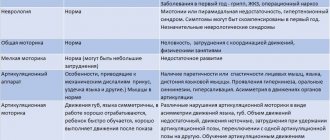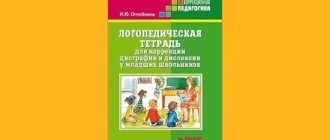Symptoms of rhinolalia
With organic rhinolalia, the diagnosis is made in infancy. From the first days such children have problems with nutrition and breathing and are susceptible to respiratory diseases.
The formation of speech in children with rhinolalia is difficult and occurs after 2 years. A sick child pronounces sounds, syllables and words late. They are unclear and difficult to understand.
In the open form, the sounds have a nasal timbre and are indistinguishable from each other. Closed rhinolalia manifests itself in a violation of the pronunciation of nasal sounds and their replacement with others. The timbre of the voice also suffers.
The disease also causes other disorders - dysgraphia and dyslexia, as well as persistent psychological discomfort. That’s why diagnosing rhinolalia and treating it is so important.
Corrective work for rhinolalia
Alla Bogdanova
Corrective work for rhinolalia
Corrective work for rhinolalia
Now we make a mustache, holding the straw with our lips. How to distinguish paresis (paralysis)
soft palate from functional nasality?
It is important to delimit paresis (paralysis)
soft palate from functional
(habitual)
nasality. This can be done in the following ways:
— The child opens his mouth wide. Speech therapist (parent)
presses with a spatula
(the handle of a spoon)
on the root of the tongue.
If the soft palate reflexively rises to the back wall of the pharynx, we can talk about functional nasality, but if the palate remains motionless, there is no doubt that the nasal tone is of organic origin (paresis or paralysis of the soft palate)
.
— The child lies on his back and says some phrase in this position. If the nasal tone disappears, then we can assume paresis (paralysis)
soft palate (the nasal sound disappears due to the fact that when lying on the back, the soft palate passively falls to the back wall of the pharynx).
Eliminating nasal tone of voice with massage and exercises
To eliminate the nasal tone of the voice, both the child, the speech therapist, and, of course, loving parents will have to work hard.
First of all, you will need to activate the soft palate and make it move. This will require a special massage. If the child is too small, adults do the massage:
1) clean, alcohol-treated index finger (pad)
with the right hand, in the transverse direction, stroking and rubbing the mucous membrane at the border of the hard and soft palate (in this case, a reflex contraction of the muscles of the pharynx and soft palate occurs);
2) the same movements are made when the child pronounces the sound “a”
;
3) make zigzag movements along the border of the hard and soft palate from left to right and in the opposite direction (several times)
;
4) with your index finger, perform acupressure and jerk-like massage of the soft palate near the border with the hard palate.
If the child is already big enough, then he can do all these massage techniques himself: the tip of the tongue will cope with this task perfectly. It is important to correctly show how all this is done. Therefore, you will need a mirror and the interested participation of an adult. First, the child performs massage with the tongue with his mouth wide open, and then, when there are no more problems with self-massage, he will be able to perform it with his mouth closed, and completely unnoticed by others. This is very important, because the more often the massage is performed, the sooner the result will appear.
When performing a massage, you must remember that you can cause a gag reflex in a child, so do not massage immediately after eating: there should be at least an hour break between meals and massage. Be extremely careful and avoid rough touches. Do not massage if you have long nails: they can damage the delicate mucous membrane of the palate.
In addition to massage, the soft palate will also need special gymnastics. Here are a few exercises:
1) the child is given a glass of warm boiled water and asked to drink it in small sips;
2) the child gargles with warm boiled water in small portions;
3) exaggerated coughing with the mouth wide open: at least 2-3 coughs on one exhalation;
4) yawning and imitation of yawning with the mouth wide open;
5)pronouncing vowel sounds: “a”
,
“u”
,
“o”
,
“e”
,
“i”
,
“s”
energetically and somewhat exaggeratedly, on the so-called
“hard attack”
.
Restoring breathing
First of all, it is necessary to eliminate the causes: carry out appropriate operations, get rid of adenoids, polyps, fibroids, deviated nasal septum, inflammatory swelling of the nasal mucosa with a runny nose and allergic rhinitis, and only then restore proper physiological and speech breathing.
It can be difficult, and sometimes even uninteresting, for a small child to perform exercises just for demonstration. Therefore, use gaming techniques, come up with fairy-tale stories, for example these:
“Ventilating the cave”
The tongue lives in a cave. Like any room, it must be ventilated frequently, because the air to breathe must be clean! There are several methods of ventilation:
-inhale air through your nose and exhale slowly through your wide open mouth (and so on at least 5 times)
;
-inhale through the mouth and exhale slowly through an open mouth (at least 5 times)
;
- inhale and exhale through your nose (at least 5 times)
;
- inhale through your nose, exhale through your mouth (at least 5 times)
.
"Snowstorm"
An adult ties pieces of cotton wool onto strings and fastens the free ends of the threads onto his fingers, thus making five strings with cotton balls at the ends. The hand is held at the level of the child’s face at a distance of 20–30 centimeters. The baby blows on the balls, they spin and deviate. The more these impromptu snowflakes spin, the better.
"Wind"
This is done in the same way as the previous exercise, but instead of threads with cotton wool, a sheet of paper is used, cut with a fringe at the bottom (remember, such paper was once attached to the windows to repel flies). The child blows on the fringe, it deviates. The more horizontal the strips of paper take, the better.
"Ball"
Tongue's favorite toy is a ball. It's so big and round! He's so much fun to play with! (The child “inflates”
cheeks. Make sure both cheeks swell evenly)
“The ball deflated!”
After long games, the ball at the Tongue loses its roundness: air comes out of it. (The child first strongly inflates his cheeks, and then slowly exhales air through his rounded and elongated lips.)
"Pump"
The ball has to be inflated using a pump. (The child’s hands perform the appropriate movements. At the same time, he himself pronounces the sound “s-s-s-..."
: The lips are stretched in a smile, the teeth are almost clenched, and the tip of the tongue rests on the base of the lower front teeth. The air comes out of the mouth in strong bursts).
"The tongue plays football"
.
Tongue loves to play football. He especially likes scoring goals from the penalty spot. (Place two cubes on the side of the table opposite from the child. This is an improvised goal. Place a piece of cotton wool on the table in front of the child. The child “scores goals”
, blowing from a wide tongue inserted between the lips onto a cotton swab, trying to
“bring”
it to the gate and get into it. Make sure that your cheeks do not swell, and that the air flows in a trickle down the middle of your tongue.)
When performing this exercise, you need to make sure that the child does not accidentally inhale the cotton wool and choke.
"The tongue plays the pipe"
Tongue also knows how to play the pipe. The melody is almost inaudible, but a strong stream of air is felt, which escapes from the hole of the pipe. (The child rolls a tube from his tongue and blows into it. The child checks the presence of a stream of air on his palm).
"Block and Key"
The child knows the fairy tale “Three Fat Men”
?
If so, then he probably remembers how the girl gymnast Suok played a wonderful melody on the key. The child tries to repeat this. (An adult shows how to whistle into a hollow key)
.
If you don’t have a key at hand, you can use a clean, empty bottle (pharmacy or perfume bottle)
with a narrow neck.
When working with glass vials, you must be extremely careful: the edges of the bubble should not be chipped or sharp.
And one more thing: watch carefully so that the child does not accidentally break the bottle and get hurt. As breathing exercises, you can also use playing children's musical wind instruments: pipe, harmonica, bugle, trumpet. And also inflating balloons, rubber toys, balls.
All of the above breathing exercises should only be performed in the presence of adults! Remember that when doing exercises, your child may become dizzy, so carefully monitor his condition, and stop the activity at the slightest sign of fatigue.
Articulation exercises for rhinolalia
For open and closed rhinolalia, it can be very useful to perform articulation exercises for the tongue, lips and cheeks. Some of these exercises can be found on the pages of our website in the sections “Classical articulatory gymnastics”
,
“Fairy tales from the life of Tongue”
.
Here are a few more. They are designed to activate the tip of the tongue:
1) "Liana"
: hang a long narrow tongue down to the chin, hold in this position for at least 5 seconds
(repeat the exercise several times)
.
2) "Boa"
: slowly stick out your long and narrow tongue from your mouth
(do the exercise several times)
.
3) "Boa Tongue"
: with a long and narrow tongue, sticking out as much as possible from the mouth, make several quick oscillatory movements from side to side
(from one corner of the mouth to the other)
.
4) "Watch"
: the mouth is wide open, the narrow tongue makes circular movements, like the hand of a clock, touching the lips
(first in one direction and then in the other direction)
.
5) "Pendulum"
: the mouth is open, a narrow long tongue is protruding from the mouth, and moves from side to side
(from one corner of the mouth to the other)
counting
“one - two”
.
6) "Swing"
: the mouth is open, the long narrow tongue either rises up to the nose, then falls down to the chin, counting
“one - two”
.
7) "Injection"
: a narrow, long tongue presses from the inside first on one cheek, then on the other.
You can also diversify articulation gymnastics
GASTRONOMIC AND Speech Therapy GAMES
Fun articulation exercises for children that they will have great fun doing because all the exercises are done with sweets!
Stick out your tongue and hold the straw on it for as long as possible. Stick out your tongue and hold the straw on it for as long as possible
Suck the chewing spaghetti into your mouth through your pursed lips. Suck the spaghetti gummies into your mouth through your pursed lips.
The same long piece of marmalade should be pressed between your lips and pulled with your hand. And you must try to hold the marmalade with your lips! The same long marmalade must be pressed with your lips and pulled with your hand. And you have to try to hold the marmalade with your lips!
Open your mouth and try to keep the straw balanced on your tongue. You can press it against your upper teeth, but you cannot close your mouth. Open your mouth and try to keep the straw balanced on your tongue. You can press it against your upper teeth, but you cannot close your mouth.
Make a mustache! Hold the straw against your upper lip using the tip of your tongue. Make a mustache! Hold the straw against your upper lip with the tip of your tongue.
Now we make a mustache by holding the straw with our lips. Now we make a mustache by holding the straw with our lips
Now the task is more difficult: the straw needs to be held in a vertical position (almost holding one end between the lower teeth and tongue. Now the task is more difficult: the straw needs to be held in a vertical position (almost holding one end between the lower teeth and tongue
Hold the candy ball (or breakfast cereal)
in the tongue, as in a cup.
Hold a candy ball (or breakfast cereal)
in your tongue, like in a cup
Lick the lollipop when it is on the side, top, bottom.
Lick the lollipop when it's on the side, top, bottom
Correction of rhinolalia at a speech therapy center in Moscow
Corrective work with children with rhinolalia should begin when a problem is detected in order to achieve positive results by adolescence. Depending on the form, speech therapy work can be the main or complementary work of other specialists.
The role of a speech therapist for rhinolalia is to consolidate sound pronunciation skills. Massage is used, the development of velopharyngeal closure, the development of exhalation and sound pronunciation, the elimination of nasality, the development of vocabulary and work on lexical literacy.
- Correction for functional rhinolalia. A positive effect can be achieved through sessions with a speech therapist. They include massage, breathing exercises, work on developing the correct pronunciation of sounds and auditory attention.
- Correction for organic form. The effectiveness depends on the surgical intervention, the timeliness of the operation and the completeness of the speech therapist’s work with the child.
REASONS FOR THE APPEARANCE
Forms and causes are interconnected. All 3 forms have their own origins.
| Open form of rhinolalia |
|
| Closed form of rhinolalia |
|
| Mixed form of rhinolalia | The intersection of some disorders and disorders of closed and open forms. |
CLASSES WITH A Speech Therapist
This method of correcting rhinolalia is used by all speech therapists. The standard list of exercises includes:
1. Exercise “Sail”. The tip of the tongue is placed on the upper row of teeth, and the back bends forward.
2. Exercise “Cup”. The wide tongue is placed on the lower lip, and the edges begin to curl into a cup shape.
3. Exercise “Hippopotamus”. The baby opens and closes his mouth calmly and without tension.
4. Exercise “Smile”. The child smiles widely, spreading the corners of his lips as far apart as possible, and then returns them to their place.
Such simple exercises will be useful even for children without speech disorders, so I recommend training for prevention purposes.
Articulation exercises
To correct articulation disorders caused by rhinolalia, special exercises are needed:
- “Snake or spade” - you need to learn to stick out your tongue with a pointed tip, and then widely flattened. The next stage is to alternate between “snake” and “shovel”.
- “Bend the back” - the tip of the tongue rests on the lower gums, and the back of the tongue curves up and down.
- “Inflate and deflate” - the cheeks need to be inflated and deflated, pulling them between the teeth. As an option, learn to inflate not both cheeks at once, but alternately. An adult can help deflate the puffy cheek by lightly touching it with a finger.
- “Rinse your teeth” - imitate rinsing your teeth without water (the air should press on your lips).
- “Elephant exercise” - the child must learn to hold his lips closed and extended forward with his “proboscis”, and then move it left and right and even rotate it.
Breathing exercises
Rhinolalics are characterized by breathing with exhalation both through the mouth and through the nose. Therefore, teaching a child to control inhalation and exhalation is very important. To control, you can use a piece of cotton wool or a napkin applied to your nose. The purpose of the exercises is to teach you to “blow” only through your mouth.
Inhale - exhale
This exercise will help you learn to control your breathing. The child inhales and exhales in a strictly defined manner. For example, inhale and exhale through your nose, the next time you inhale and exhale only through your mouth. We complicate the task - inhale through the nose, exhale through the mouth, the next inhale-exhale through the nose, then only through the mouth. And so on.
Storm in a teacup
Playing with water will help to visually control your mouth breathing. Children enjoy blowing into the water through a straw, creating real storms and storms. To prevent the water from splashing, it is more convenient to take a bottle rather than a wide glass. Just be sure to be transparent so that the seething is clearly visible. When the child learns to blow into a tube, creating a gurgling sound, you need to try to lengthen the exhalation. For the storm to be “real,” the exhalation must be uniform and long.
Games for blowing out candles, kicking soccer balls made from cotton balls, various toy wind instruments and blowing up balloons are also very useful. However, what is important here is the gradual complication of the task and the absence of overload. Breathing exercises should not be long, so that the child does not feel dizzy.








